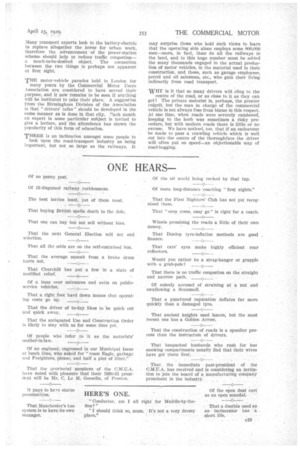LOOSE LEAVES j J UST as in aeroplane practice the general layout of the engine is largely controlled by the
Page 42

Page 43

If you've noticed an error in this article please click here to report it so we can fix it.
need for reducing head
resistance to a minim-1m, so in the future forward-control bus a compact engine, suited to the space available, will no doubt displace the ordinary vertical type. The suitability of the horizontally opposed eight-cylindered unit for this purpose was recently suggested in The Commercial Motor, and our views on this matter have
attracted considerable attention. We have also heard of certain interesting eTperiments which are being parried out with various other and quite unorthodox types of engine designed to take up as little space as possible in chassis of this variety. A notable feature of the commercial-vehicle indus try is the readiness with
which manufacturers turn to new ideas for improving the ejficiency of their products, and there is no doubt that before long special types of power unit will be evolved for the purpose in view ; some of these may be exhibited at Olympia next atitumn.
AFTER seeing the illustration of a piccaninny's model of a Thornycroft six-wheeler which we published recently, a lady reader sent us an illustration of a very neatly constructed model of a Leyland made by her son, age 13, the vehicle belonging to a well-known milling company in Sunderland. As will be seen from the illustration which we reproduce, it is built up from Meccano parts, and we note with interest that it has won a large number of prizes at various exhibitions. The model is driven by an electric motor.
ONE of the results of the electric power-station scheme, now in its infancy, is sure to be the spread of the battery-electric vehicle. Municipal users have been very partial to the type, because In so many instances power is cheap and easily obtained from the corporation mains. These facilities have not been so readily available to the private owner, especially 'when only one vehicle he used. Many transport experts look to the battery-electric to replace altogether the horse for urban work, therefore the advancement of the power-station scheme should help to reduce traffic congestion— a much-to-be-desired object. The connection between the two things is perhaps not apparent at first sight.
THE motor-vehicle parades held in London for many years by the Commercial Motor Users Association are considered to have served their purpose, and it now remainsto be seen if anything will be instittited to take their place: A suggestion from the Birmingham Division of the Association is that "drivers' talks" should be developed in the same Manner as is done in that city. nach month an expert in some particular subject is invited to give a lecture, and the attendance has shown the popularity of this form of education.
THERE is an inclination amongst some people to look upon the road-transport industry as being important, but not so large as the railways. It may surprise those who hold Such views to learn that the operating side alone employs some 800,000 men—more, in fact, than. do all the railways in the land, and to this huge number must be added the many thousands engaged in the actual production of motor vehicles, in the material used In their construction, and those, such as garage employees, petrol and oil salesmen, etc., who gain their living indirectly from road transport.
WHY is it that so many drivers will cling to the centre of the road, or as close to it as they can get? The private motorist is, perhaps, the greater culprit, but the man in charge of the commercial vehicle is not always free from blame in this respect. At one time, when roads were severely cambered, keeping to the kerb was sometimes a risky procedure, but with modern roads there is little or no excuse. We have noticed, too, that if an endeavour be made to pass a crawling vehicle which is well out into the centre of the thoroughfare the driver will often put on speed—an objectionable way of road-hogging.














































































































